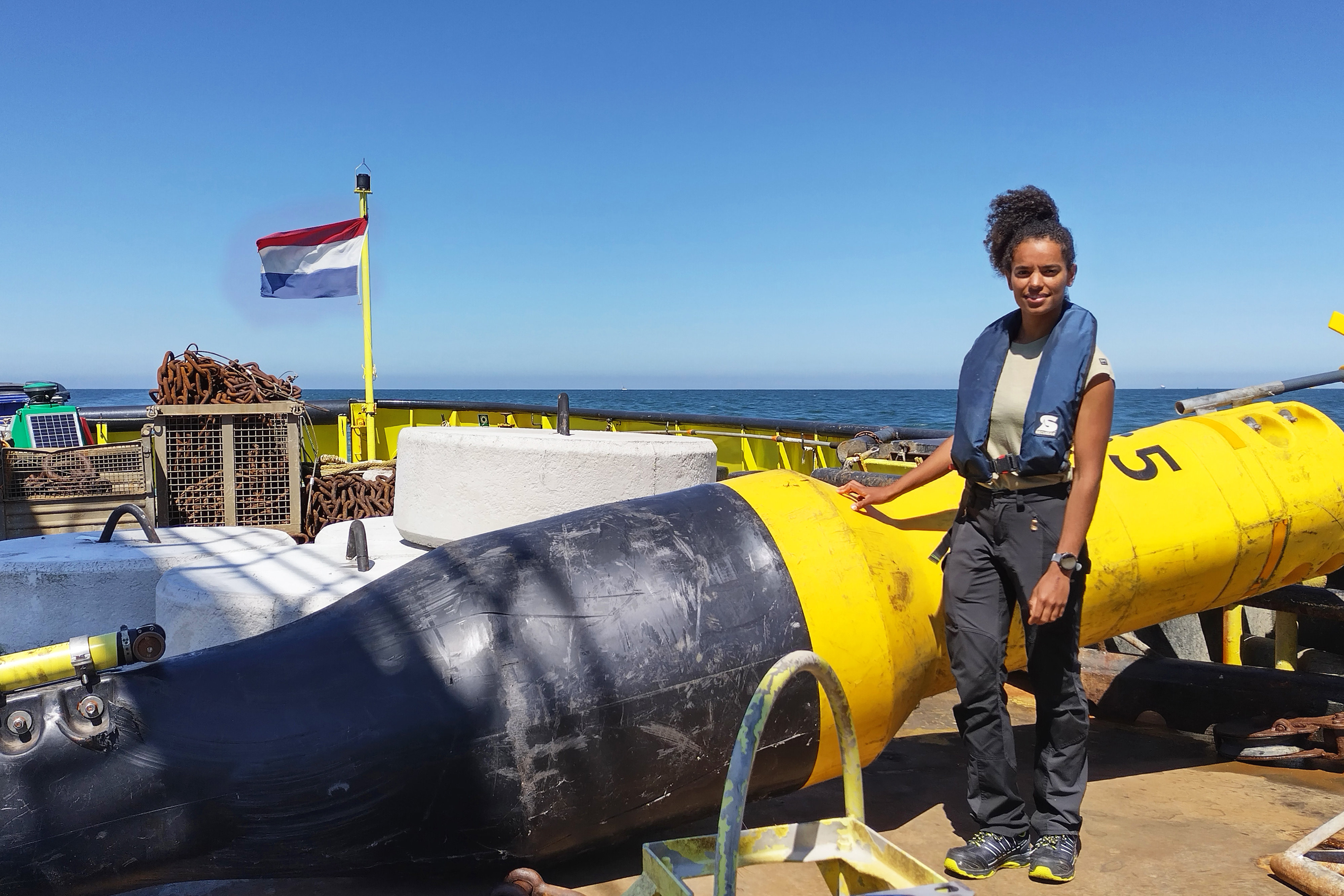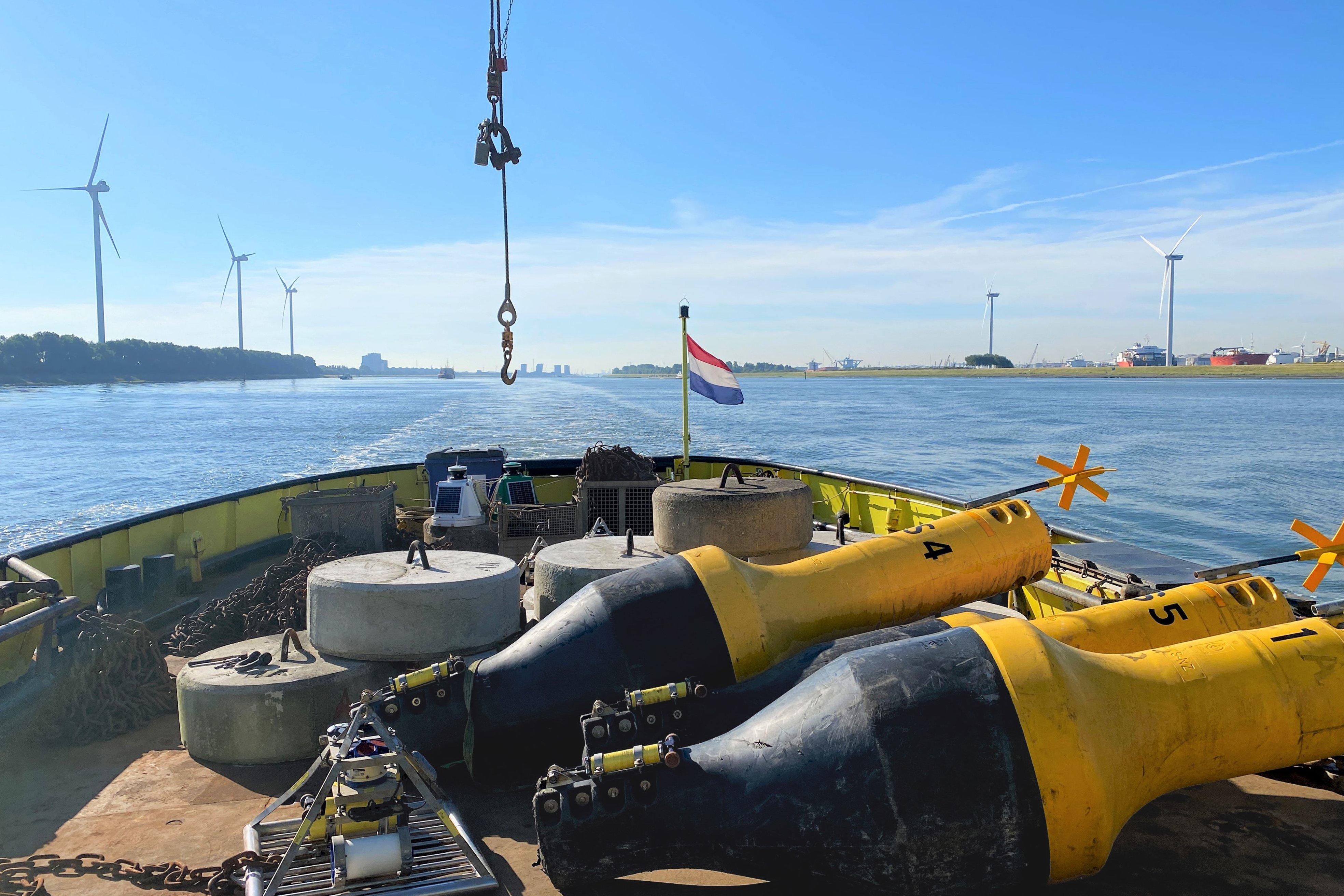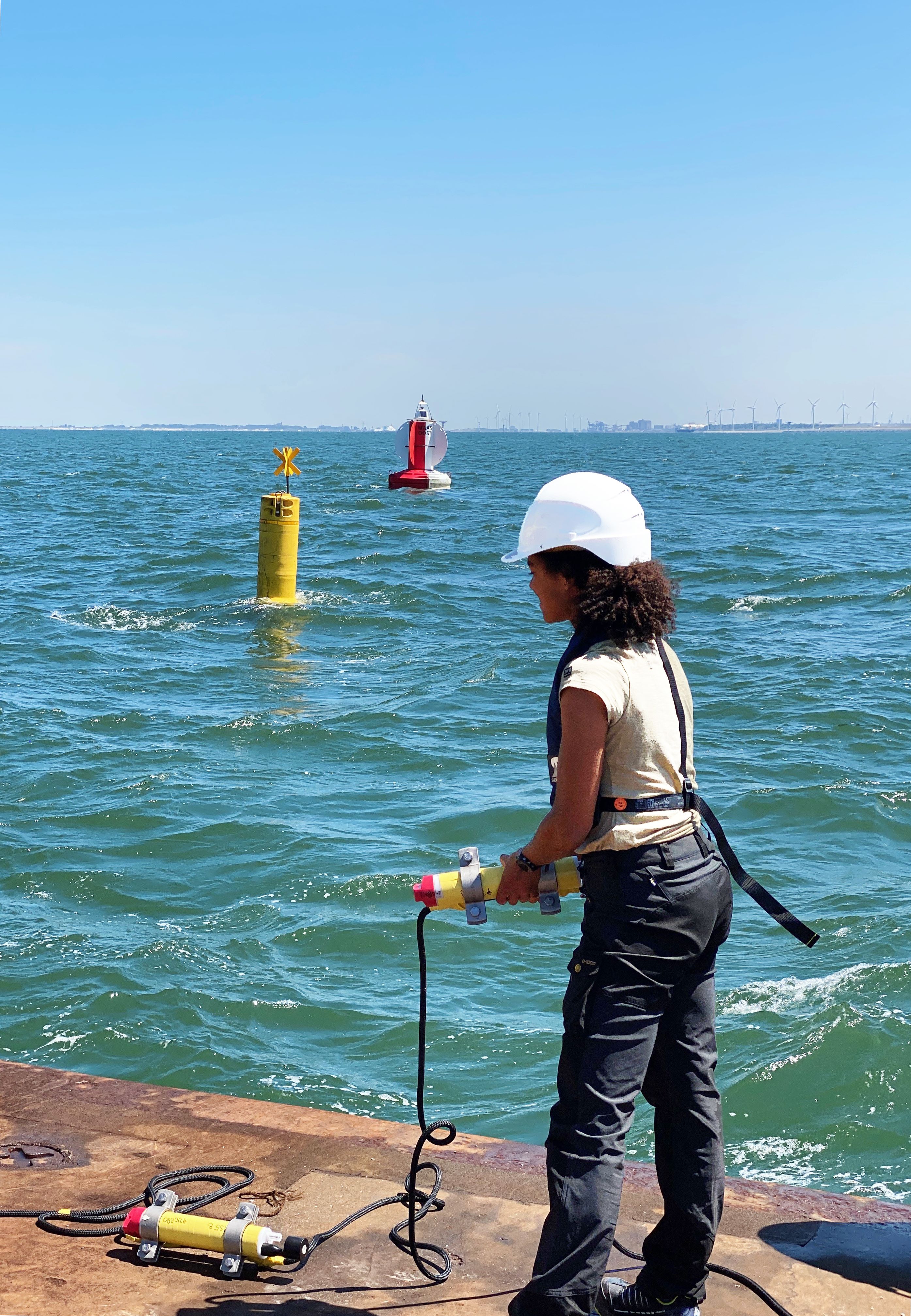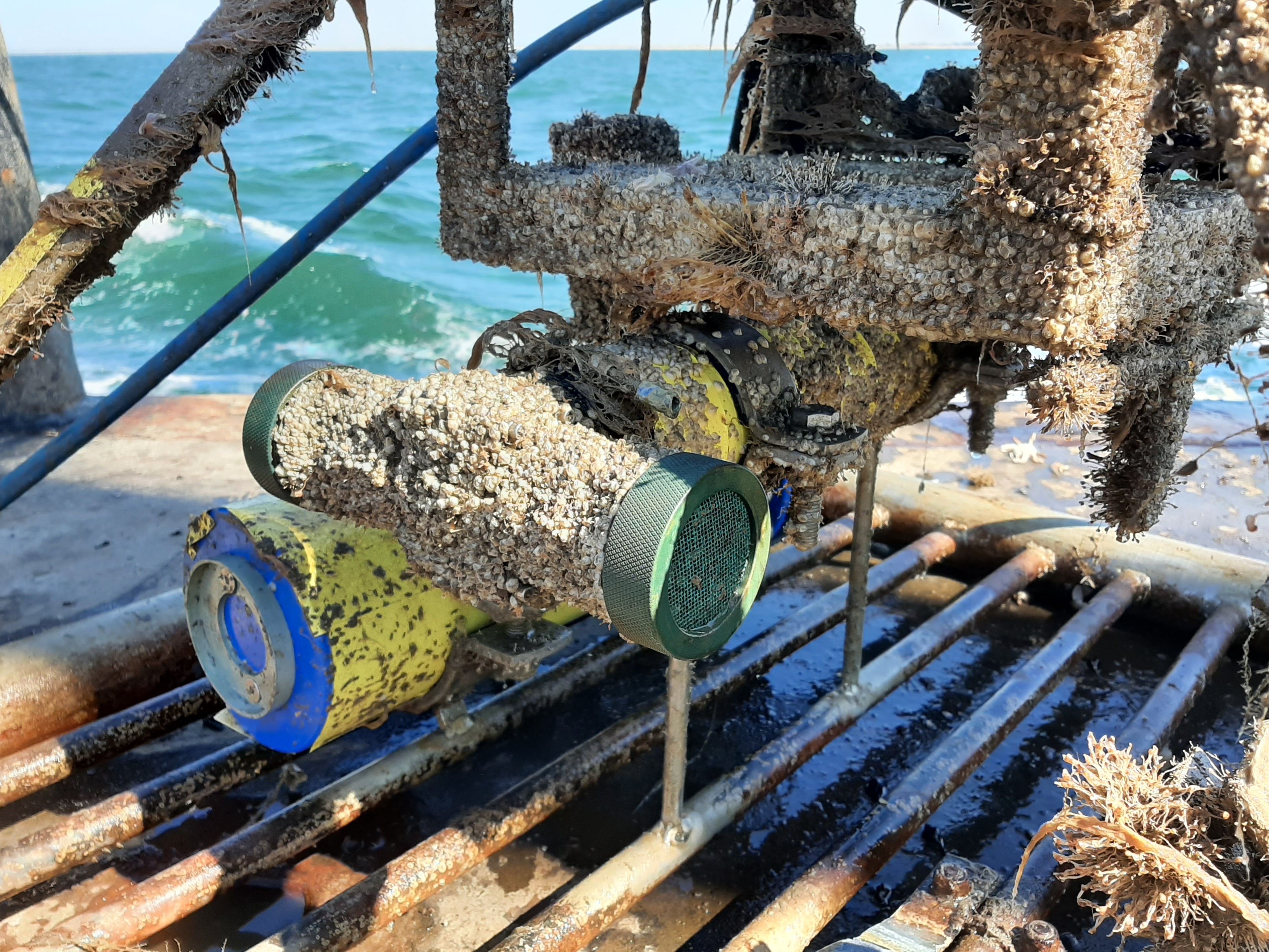River water is becoming saltier and that is not good news for our drinking water. To find solutions, researchers are working hard to understand when and how salt intrusion happens. Hydraulic engineering PhD candidate Tess Wegman is fascinated by the behaviour of saltwater and freshwater flows taking place beneath the surface of the water.
‘Well, I did it,’ Wegman thought, as the last of her research equipment was loaded onto the deck of the Frans Naerebout. The buoy-laying vessel of Rijkswaterstaat (the Dutch Ministry of Infrastructure and Water Management), packed with concrete disks weighing 3,000 kilos each, one by one metre pyramid shaped frames, metres-long chains, ropes equipped with salinity sensors, huge rubber ‘balloons’ and buoys named MS1 (measuring station) to MS6, was ready to weigh anchor.

Seeing the black lettering on the yellow buoys “really brought to life the places I had been marking on the map of the Rhine-Meuse Delta”, Wegman says. Her aim, to find out the dynamics of salt intrusion on the spot, shows she is not afraid of a challenge. For seventeen weeks she brought out the hefty equipment to measure seawater exchange in the Rhine-Meuse Delta near Rotterdam.
Initially planned to take just seven weeks, the extremely dry weather conditions of the summer of 2022 offered Wegman the “perfect” conditions for her research. She managed to convince Rijkswaterstaat to facilitate another ten weeks of field work to complete the project. “It was a long summer but I learnt a lot”, she says.
Salt intrusion
The amount of salt in our rivers has been increasing over the years, endangering the availability of freshwater for drinking. Farming and industry, too, will be affected by a shortage of freshwater. To understand and tackle salt intrusion, five Dutch universities, Rijkswaterstaat, water boards, research institutes, consultancies, port authorities and dredging companies have come together to carry out a six-year NWO-funded project called SALTISolutions, led by Wegman’s promotor Julie Pietrzak.
Just how far saltwater penetrates into a river varies with river discharge. The extremely low discharge during the dry summer of 2022 makes it much easier for the salt water to intrude far inland. Spring tide, neap tide and wind at the mouth of the estuary also influence salt intrusion. “That is the overall picture, but the relationship between the Rhine river plume (the body of freshwater discharged from the river into coastal waters) that flows along the Dutch coast and salt intrusion has not been investigated before”, Wegman says.
Wegman’s fieldwork will tell her which of the elements affecting salt intrusion plays the biggest role. A faithful digital representation of the Rhine-Meuse Delta run by colleague Marlein Geraeds allows her to see how her fieldwork results compare. The numerical model enables Geraeds to test the effectiveness of Rijkswaterstaat measures, such as water diversion and restrictions on river water extraction.


Rubber balloon
By placing conductivity sensors in a straight line above each other, Wegman was able to get a good sense of the vertical salinity distribution. But how do you make sensors float in the water at different depths? Her solution was to attach the sensors to a rope fastened at one end to a concrete block on the riverbed and at the other end to a floating rubber ‘balloon’. The balloon had to be of a certain size, she found: too big and the current would pull it sideways, too small and the balloon would lack buoyancy.
The large surface buoys, concrete blocks and triangular frames were provided by Rijkswaterstaat but finding the right size rubber balloons was less straightforward. “I think I must have rung every fisherman in Urk to ask if they had the right buoys”, Wegman laughs.
We waited with baited breath each time to see if they were still there.
At sea for science
The moment the first measuring station, MS1, was put in place was “one of the most exciting things” to happen during the project. A crane hoisted the first concrete block over the side, helped by a nonchalant kick from a muscular crew member in shorts and orange wellies. Wegman and two of her colleagues kept a protective hold on the chain with the sensors. “It’s very rough and coarse equipment but the sensors are vulnerable”, she says. As the chain was carefully lowered down, the last of the sensors disappeared beneath the surface.


After placing all nine measuring buoys – six at sea and three in the New Meuse – Wegman went back at three to four week intervals to remove biofouling caused by the heat. “Hauling them up, cleaning them, checking if everything was still properly attached…it was hard work”, Wegman says.
The metres-long chains attached to the equipment enabled Wegman and the crew to locate and haul up the installations that were not fastened to a buoy. “We waited with baited breath each time to see if they were still there. They could so easily have been run over by a fishing boat”, Wegman says. At times it took various attempts with the grappling hook to get hold of the chain. See fragment on Atlas TV (in Dutch).
It was exactly the set of circumstances I needed for my research.
13-hour measurements
Wegman spent two days from 5 am to 6 pm measuring salt intrusion during a complete tidal cycle as the ship went on its way. Apart from a couple of curious seals, the trips were fairly routine, Wegman says. “It’s not as if you’re speeding along at a rate of knots. You really have to take it slowly or you mess up the measurements.” Wegman did enjoy the incoming real time data produced by the ship’s flow meter which enabled her to see the sub-surface waves which occur where the layers of freshwater and saltwater meet. “Internal waves are a fascinating sight invisible on the surface”, Wegman says.
A sensor full of seawater
Sitting behind her desk in Delft Wegman did not get any feedback from the fixed measuring stations whose data were being stored under water. After seven weeks she decided to replace the installations as batteries were running low. She could finally net her first set of data. Unfortunately, one of the sensors had been taking in water. “I thought it was a lost cause but some very clever people at the Faculty of Electrical Engineering, Mathematics & Computer Science managed to extract the data. That was a happy moment”, Wegman says.
An extremely dry summer
Wegman’s strenuous efforts paid off. The measuring period, which had been planned for two years, turned out to be exceptionally propitious. The summer of 2022 was extremely hot, with river water levels at an all time low. “It was exactly the set of circumstances I needed for my research”, Wegman says, “because drought promotes salt intrusion. In the end we were able to detect salt water, as far as and beyond, Ouderkerk aan de IJssel”.
Header photo: Alexander Horner-Devine (University of Washington)
Published: May 2023

